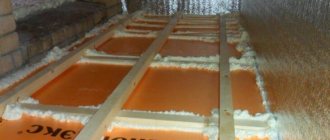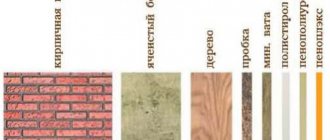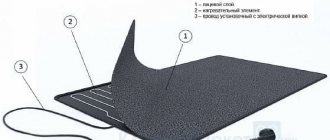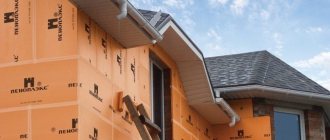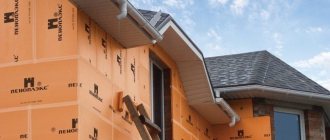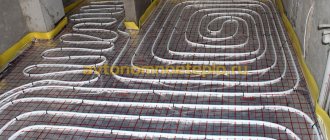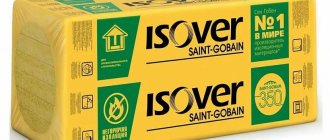Modern private houses are equipped with autonomous heating, water supply and sewerage systems. Many city residents are attracted by the ability to independently turn on and off the heating as needed. In addition, living in a private house, people decide for themselves how to heat their home: hang radiators, install a water-heated floor system, or use both heating methods at the same time.
Water heated floor on penoplex
However, the level of comfort in a private home depends, first of all, on the high-quality insulation of walls, ceilings and floors. And given that the main part of heat loss occurs through the floor, it is this floor that requires careful insulation.
Penoplex for heated floors
It is no secret that a water heated floor system is the best option for increasing the level of comfort. However, laying the pipeline without preliminary insulation will make the system ineffective. Despite the variety of materials used for floor insulation under water heating systems, the most effective today is penoplex - extruded polystyrene foam boards. How is a water-heated floor installed on penoplex, and should it be used at all?
Distinctive features of penoplex
Penoplex is a heat-insulating material used in construction. It is obtained by foaming polystyrene, squeezing the resulting material through a molding hole. As a result of these manipulations, the structure of polystyrene is supplemented with micropores filled with air. This technology makes it possible to obtain a durable material with high thermal insulation properties from ordinary foam plastic.
The thickness of the slabs varies from 2 cm to 10 cm. The slabs can have the following dimensions:
- 60×120 cm;
- 60×240 cm. Physical properties of penoplex
Expanded polystyrene differs from other materials laid under heated floors in a number of advantages.
- Due to its special structure, this material does not absorb moisture at all.
- Penoplex has the lowest thermal conductivity coefficient.
Benefits of penoplex - The composition of polystyrene foam prevents the formation of fungus and mold.
- Despite its low weight, this material is very strong and durable. You can install even the heaviest furniture on the floor without fear for the integrity of the insulation.
- Expanded polystyrene slabs are easy to lay, cut and fasten together.
Laying a heated floor on insulation allows you to heat the room, and not the floor or basement. Due to the low thermal conductivity of penoplex, the heat flow is not dissipated downward, but is directed strictly upward.
Warm floor on penoplex
[ads-mob-1][ads-pc-1]
Specifications
They may differ slightly for different types of PPP. The table below shows the main average technical indicators of the characteristics of extruded polystyrene.
| Insulation characteristics | Meaning |
| Water absorption during the day | 0.5% of the total volume |
| Vapor permeability coefficient | 0,005 |
| Fire resistance | Group G4 |
| Density | From 20 to 50 kg/m3 |
| Specific heat | 1.45 kJ |
| Coefficient of thermal conductivity | 0,034 |
| Standard sizes | 1185 x 585 x (20 - 100) mm |
How to lay a heated floor on polystyrene foam under a concrete screed
Installation of a water heated floor with a concrete screed
Work should begin with preparing the base. To do this, it is cleaned of old coating, debris, grease and dirt. The base must be level, so all existing defects and irregularities are puttied or sealed with cement mortar.
Next, a layer of waterproofing is laid on the prepared rough base, which can be roofing felt or ordinary polyethylene film with an overhang of about 15 cm onto the walls.
It should be taken into account that during the operation of the heated floor, the concrete screed will heat up and expand. To avoid cracking, it is necessary to glue a damper tape around the entire perimeter of the room, which will serve as an expansion compensator.
Manufacturing technology of semi-dry polystyrene foam screed
Next, the foam boards are laid joint to joint. To avoid heat loss, insulation boards should be pressed as tightly as possible against the walls. And all joints must be taped with construction tape, which will not allow moisture from the concrete mixture to penetrate inside the insulation.
Application of penoplex
Penoplex slabs can be smooth or have special grooves and protrusions that allow you to lay the contours of a heated floor without applying appropriate markings. When using the first option, a mounting mesh should be placed on the insulation, to which the pipeline will be attached. If the foam boards are equipped with grooves, a mesh will not be needed.
Now you can begin laying the pipe according to the pre-selected pattern. The pipes are secured with clamps to the mounting grid. Next, you should pressurize the system and, while maintaining the working pressure in the pipes, pour a concrete screed, the thickness of which can be 3-5 cm.
Electric underfloor heating is installed in the same way. The system cable is fixed to the mounting grid. When installation is complete, the system is checked for functionality and filled with concrete screed. If it is planned to install a heated floor on the ground, an additional layer of thermal insulation consisting of a sand cushion is laid under the waterproofing and penoplex slabs.
Necessary tools and materials for installing penoplex
After the screed has dried, you can begin laying the topcoat. It is very important that it transmits heat well, otherwise floor heating will be ineffective.
And when using an electric heating option, the low thermal conductivity of the finish can completely destroy the underfloor heating system.
You can start using water and electric heated floor systems only after the cement-sand mixture has completely dried.
This period averages 28 days. Conventional concrete mixture can be replaced with self-leveling one. Then the drying time of the screed will be significantly reduced.
Self-installation of insulation
Before work, craftsmen stock up on the necessary materials at hand:
- a new type of foam insulation;
- adhesive agent;
- measuring device (level);
- installation reinforced mesh;
- priming material;
- polyethylene film.
The installation of penoplex begins with a good cleaning of the working area from debris and unnecessary things. Then the insulating material is laid out around the perimeter of the floor. Clearances and gaps should not be allowed.
The tiles need to be joined together and glued with tape. Next, according to the standard scheme, installation is carried out with filling with a finishing screed.
Laying a heated floor
Expanded polystyrene for heated floors on wooden logs
Concrete screed promotes uniform heating of the floor. However, if laying it is not possible, water circuit pipes can be mounted in heat distribution plates.
At the initial stage of installation of a warm circuit using a concrete-free method, a rough foundation is also prepared: it must be smooth and clean. A layer of waterproofing and foam boards are laid on the subfloor, secured together with construction tape.
The main difference between the flooring method and the concrete method is the impossibility of using smooth foam boards. It is very important that they are equipped with grooves into which the heat distribution plates will be inserted. The water circuit pipes are laid in grooves that are equipped with heat reflectors.
The electric heating option can be installed on polystyrene foam without a screed only if special mats, rather than a cable system, are used.
Installation of a lightweight, floor heating system
Next, as in the previous case, they check the functionality of the systems and begin laying the finishing coating. The laminate can be laid directly on the heat reflectors by first placing a backing on them. And tiles and other coatings approved by the manufacturer for use with heated floor systems require a flat surface. Therefore, a sheet of plywood, OSB or moisture-resistant plasterboard is laid on the heat distribution plates.
Heat distribution plates in floating floors
In wooden houses, water circuits are most often installed in special wooden modules installed on foam boards. Heat distribution plates are also installed in the modules, into which a water circuit pipe or electrical cable is placed. When using the laying method of laying contours, the thickness of the floor increases slightly.
Pros and cons of EPS
Penoplex is more expensive than regular polystyrene foam, but its price is quite justified. EPS has a lot of undeniable advantages, however, the material also has disadvantages.
Advantages
Among the positive qualities of extruded polystyrene foam, several strengths can be noted. These include:
- Environmentally friendly. Since EPS does not emit harmful substances into the surrounding space, it can even be safely used to insulate the floors of children's rooms.
- Ease of use. Unlike polystyrene foam, penoplex can be cut very well with a sharp knife. There are also few crumbs left.
- High moisture resistance. It is determined by the structure of the material itself, which is why penoplex is used for internal and external insulation.
- Resistance to mechanical deformation. This is the main advantage of penoplex, thanks to which it is so popular for floor insulation.
- A high degree of sound and heat insulation, along with a small thickness and lightness, make the insulation almost ideal for apartments in multi-storey buildings.
- Long service life. Manufacturers of extruded polystyrene foam assure that this insulation, with error-free installation, will last 50 (or more) years.
- Some types of slabs are equipped with counter-directional protrusions, guaranteeing almost one hundred percent solidity of the heat-insulating layer without additional sealing.
These advantages of penoplex provide a chance for simple, relatively quick insulation of the balcony floor; despite the speed of work, it will be of high quality.
"Long Minus"
Good material has disadvantages: it is afraid of solvents and very high (low) temperatures, but this disadvantage can be ignored. But it should be noted that the price is quite decent, which cannot be considered an advantage either.
But penoplex has one big disadvantage - the relative ease of ignition and the release of toxic substances during combustion. To protect polystyrene foam, fire retardant additives are added to it. But it’s easy to combat this “weakness” - just place the insulation between layers of some non-combustible material.
Since the shortcoming is significant, it requires some explanation. All building materials are divided into 5 groups, differing in the degree of flammability. The safest ones are “NG” - non-flammable. Its “bright” representative is mineral wool. The most unreliable group is “G4”. The materials included in it are capable of spreading flames. An example is ordinary white foam.
There are several brands of penoplex; they are intended for different areas of the apartment, so they must differ in flammability class. Manufacturers position some brands (with fire retardant additives) as belonging to “G1” - the group that contains low-flammability, self-extinguishing types; they are not characterized by the spread of fire.
In reality, everything is not so rosy, this is the opinion of the builders. They are more skeptical and classify almost all brands of penoplex into the “G3” and “G4” groups. It contains materials that are quite difficult to ignite, burn steadily, but tend to fade. Extremely toxic smoke is the main danger to humans: it should not be inhaled under any circumstances.
If you plan to insulate the floor with penoplex yourself, then the best type for any premises, and especially for small balconies, are brands with a minimum degree of flammability
Reliably fencing them with materials that are not afraid of fire is the most important condition, and it is also quite feasible. Therefore, recently extruded polystyrene foam has been successfully squeezing out its competitors - mineral wool and polystyrene foam, because the list of its disadvantages is very small, but its advantages are significant
Types of expanded polystyrene
The laying technology depends on the characteristics and type of material. Construction stores offer a lot of thermal insulation materials. Let's look at the strengths and weaknesses of the most popular ones.
Profile
Expanded polystyrene (profile) mats consist of a foam base and bosses located on the surface. Volumetric parts make it easier to install heated floor heating elements. No fasteners or additional equipment are needed during the work. The raw materials have side locks, ensuring a monolithic structure without seams.
Profile mats have a solid vapor barrier layer that protects the material from condensation. Expanded polystyrene boards with foil lamination will not be destroyed by chemicals in the screed. The textured surface on the back improves ventilation.
Winding for pipes Source otoplenieblog.ru
Insulation on top of the ground
To carry out the work we will need:
- gravel or small crushed stone;
- sand and cement;
- building level and rule;
- tamping device;
- reinforcing mesh;
- metallized tape;
- moisture-proofing material;
- metal beacons;
- alabaster;
- penoplex.
To install this type of thermal insulation, you need to lower the ground level by 500 mm from the finished floor. There should be no voids in the soil, otherwise the future foundation will shrink unevenly, which will cause destruction of the floor.
